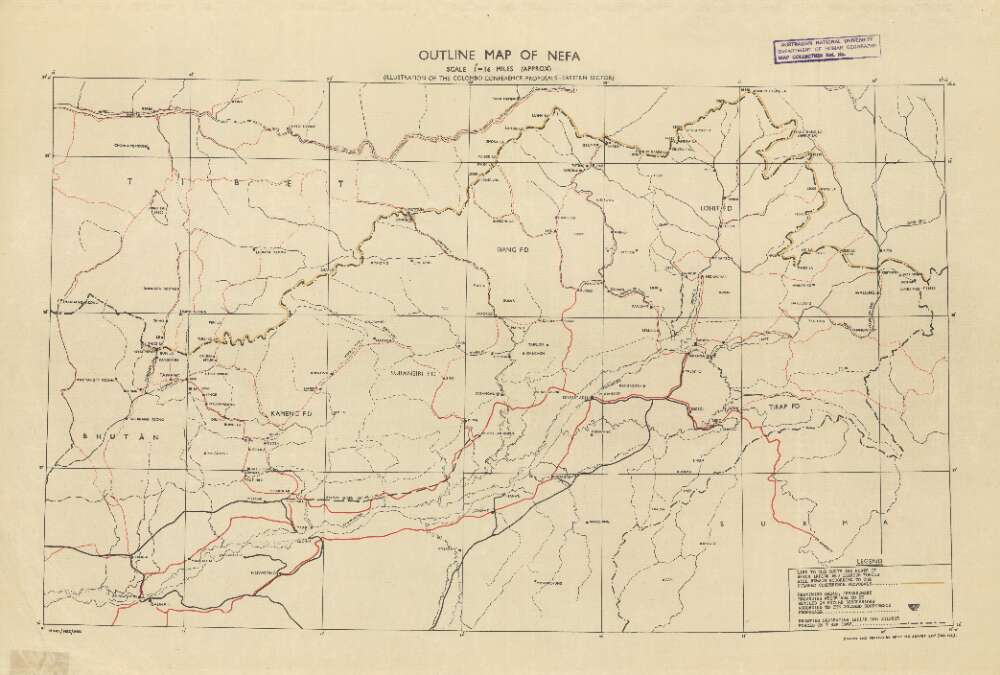Disintegration of Assam
Demand for a hill state on account of discontent between highlanders and plainsmen, coupled with the British need to establish buffer at frontiers, created the ground for carving out of Nagaland from Assam

As such within the first decade of the independence, the ethnically and linguistically diverse groups sought the reorganization of state. The representatives of all the hill tribes of Assam met in Tura in 1954 to prepare a memorandum for the States Reorganization Commission, demanding a Hill state, as 'the autonomy granted by the Sixth Schedule was not real and substantial'. The structure of the proposed Hill state included a legislative assembly, a council of ministers and a governor who would also be responsible for the administration of NEFA which ultimately should be a part of the Hill state. It was agreed that the Hill state and the residual state of Assam should have a common High Court, Public Service Commission, Accountant General and, in the interim, Shillong as the common capital. However, the counter proposal from Assam was a state for the entire eastern Himalayas, including Darjeeling, Jalpaiguri, Cooch Behar and NEFA!
Proposals were also made for the formation of Kamatapur state consisting of Goalpara, Garo Hills, Cooch Behar, Darjeeling and Jalpaiguri, besides a Purbanchal state consisting of areas in and around Cachar. However, the commission was guided by the principle that a border state should be a well-administered, stable and resourceful unit, capable of meeting emergent problems arising out of military exigencies. The commission felt that it would be safer to have relatively larger and resourceful states at the border, rather than small and less resilient units. Even while recognizing the multi-racial and multi-linguistic character of the state, it recommended that the new state of Assam will include all the existing areas, besides the incorporation of Tripura and Manipur. The SRC Commission thought that this would bring the entire border between India and Pakistan under one single control — namely the government of Assam. The commission was of the view that "separation will add to the cost of administration and render difficult coordination of policies and programmes between the state of Assam and hill areas on the one hand, and the hill districts themselves, on the other."
Even though the SRC was not in favour of any division of Assam, the Government of India, especially Prime Minister Nehru, was keen to enter into a political settlement with that section of Naga leadership which agreed to eschew violence and enter into negotiations. The Central government realised that the main antipathy of the Nagas was with the conduct of overzealous officials of Assam rather than with the Government of India.
When the Indian Statutory Commission (Simon Commission) visited India in 1929, the Naga Club — a representative body of the Nagas — prayed for exclusion of the Naga Hills from the Reform Scheme in their petition and wanted it to be placed 'directly under the British government'.
The formation of Nagaland is also closely aligned with the question of the construction of Naga identity, the British quest for having frontiers as buffers, their ideas about retaining Nagaland as a Crown colony, the implicit support for the missionary activities and the distrust between the highlanders and the plainsmen (as in many other regions across the world), besides the easy availability of ammunition dumps left by the armies of the Allied and Axis powers at the end of the World War II.
From a chronological point of view, the story of "the district becoming a state" starts with the establishment of the Naga Hills district in 1866 with its headquarters at Samaguiting, and from 1878 at Kohima with a subdivision each at Wokha and Mokokchung. Under the Bengal Eastern Frontier Regulation, 1873, the Inner Line Permit (ILP) was introduced — thereby legally restricting the contact with the rest of the country. The GoI Act of 1935 created the Excluded and Partially Excluded Areas and outlined the relationship of the Viceroy/GG towards these territories.
The iron curtain, created by the ILP was breached by the two World Wars. Nearly 4,000 Nagas were recruited during WW-I for a Labour Corps in France and, during the WW-II, the entire region became a theatre of War. The Axis (Japanese) troops were at the steps of Kohima before they were finally routed; Field Marshal Sir William Slim acknowledged the role of the brave Nagas in his monumental book, 'Defeat into Victory':
There were the gallant Nagas whose loyalty even in the most depressing times of the invasion had never faltered. Despite floggings, torture, execution and the burning of their villages, they refused to aid the Japanese in any way, or to betray our troops. Their active help to us was beyond the value of praise. Under the leadership of devoted British political officers, they guided our columns, collected information, ambushed enemy patrols, carried our supplies and brought in our wounded under the heaviest fire—and then being the gentlemen they were, often refused all payment. Many British and Indian soldiers owe their life to them, and no soldier of the Fourteenth Army who met them will ever think of them but with admiration and affection."
No wonder then, that the administrator-anthropologist JH Hutton, who had been a Deputy Commissioner in Assam, and Governor Sir Robert Reid were keen to place these frontier areas on the Burmese border as a Crown territory directly under Whitehall but, as VP Menon in the newly constituted States Ministry got wind of it, he had this stalled at the level of the Secretary of State.
Meanwhile, a delegation of Naga leadership, including AZ Phizo and T Sahkire, met Mahatma Gandhi in May 1947 at New Delhi, who conveyed to them that although he felt that Nagas were an integral part of India, it was for them to decide the modalities of their participation in the Indian Union, and that the use of force was out of question.
Views expressed are personal



